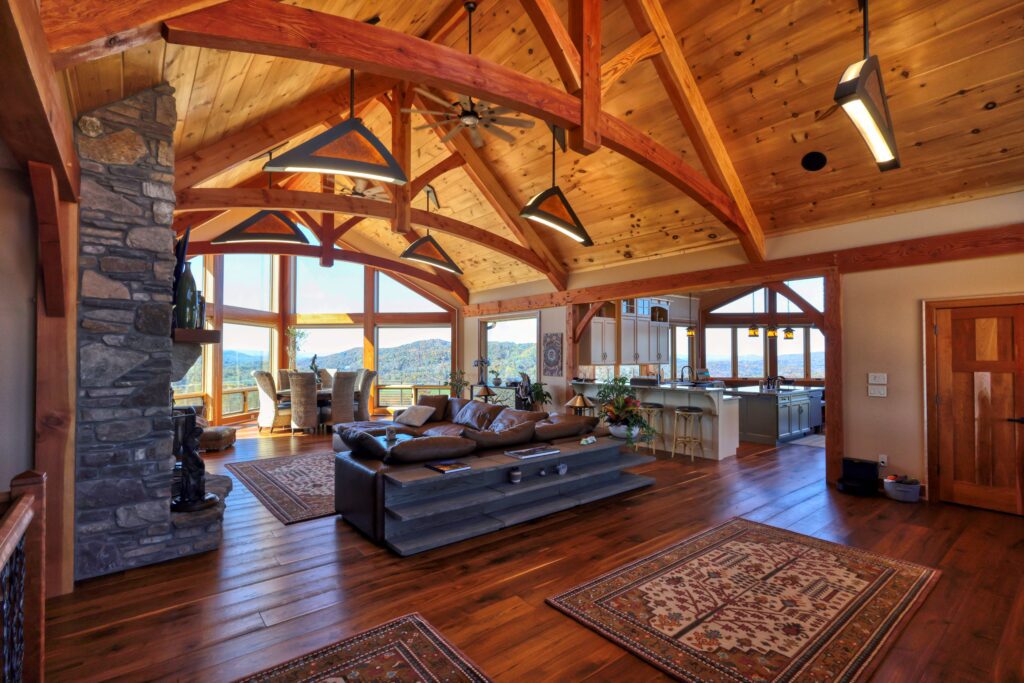How to Choose Between a Timber Frame or Traditional Home
Building a home is one of the most significant investments you can make. Choosing the right construction method is crucial in creating a home that meets your needs, budget, and style; for individuals, building a house can be extra challenging with the varying terrain and weather conditions.
Two popular building methods for homes are timber frames and traditional-built houses. Both have their benefits and drawbacks. This blog post will compare timber frames and traditional build homes to help you determine the correct construction method. By understanding these factors, you’ll be better equipped to decide when choosing your dream abode. So, whether it’s the rustic charm of timber frames or the time-tested appeal of traditional homes, let’s explore what each has to offer.

Aesthetic Appeal
Timber frame homes possess a unique aesthetic, ranging from rustic to modern, that sets them apart from traditional homes. The visible wooden beams, high ceilings, and open-plan layouts characteristic of timber frame houses appeal to those who value a blend of antiquity and modernity. The wood’s natural grain offers an authentic touch that cannot be emulated by artificial materials, adding an element of charm and warmth to the home.
In contrast, traditional homes tend to lean more towards a classic and refined aesthetic. They embrace a timeless design that relies on familiar architectural elements such as pitched roofs, brick or stone exteriors, and more compartmentalized floor plans.
While both construction methods offer unique visual appeals, deciding between a timber frame and a traditional home depends on personal preference. Some individuals may be drawn to timber’s distinctive character and natural beauty, while others may favor traditional constructions’ familiarity and timeless elegance. Each style has its unique charm and advantages, providing various options for prospective homeowners.
Structural Integrity
Timber frame homes are renowned for their remarkable structural integrity. The strength of a timber frame building lies in its post and beam construction, where large timber pieces, expertly joined, form an intricate framework that can bear significant loads. This construction technique has been used worldwide for millennia, with many ancient timber frame buildings still standing as a testament to this method’s durability.
When properly treated and maintained, timber’s natural resilience can withstand harsh weather conditions, from blizzards in the mountains to high winds along the coast. Furthermore, timber frames, especially when coupled with advanced building technologies like Structural Insulated Panels (SIPs), can offer excellent thermal performance, making these homes energy-efficient over time.
In comparison, traditional homes are built using stick framing techniques, which rely heavily on smaller-sized lumber and sheathing for stability. While this method is quicker and more cost-effective in the short term, these homes may not offer the same level of durability over the long term as timber frame homes. Stick-built homes are prone to structural shifts over time, resulting in cracking, warping, and more significant structural damage.
However, it’s important to note that the longevity of both timber frame and traditional homes depends on regular maintenance, the quality of materials used, and the construction techniques employed. Both can be robust and durable options, but the solid, enduring nature of timber frame homes often gives them the edge when it comes to lasting strength and structural integrity.
Versatility of Design
Timber frame homes provide immense flexibility in design, allowing for open floor plans, high ceilings, and prominent window placements that take advantage of natural light. This openness creates an inviting space that can easily be customized to match specific lifestyle needs and aesthetic preferences.
The interior layout of a timber frame home can be easily altered without affecting the house’s structural integrity. This is because the load-bearing timber structure is separate from the interior walls, allowing homeowners to design their interior space as they wish. Timber frame homes can incorporate various architectural styles – from modern and contemporary designs to rustic and traditional aesthetics. This versatility makes timber frame homes suitable in multiple settings, whether a coastal retreat, a mountain cabin, or a suburban dwelling.
On the other hand, traditional homes often have more limitations regarding design customization. The load-bearing walls generally dictate the interior layout, making significant changes to the floor plan more challenging and costly. Traditional homes also typically follow established architectural styles and conventions, which may limit the scope for unique or unconventional designs.
Efficiency and Environment
Timber frame homes often excel in terms of energy efficiency. The enveloping nature of a timber frame, coupled with modern insulation materials, creates a tight thermal seal that prevents heat loss and promotes thermal efficiency. With SIPs, timber frame homes can achieve superior insulation values compared to traditional homes, leading to substantial energy savings over time. Plus, thanks to the substantial thermal mass of timber, these homes can naturally regulate indoor temperatures, staying cool in summer and warm in winter, reducing the need for artificial heating and cooling systems.
From an environmental perspective, timber is a renewable resource, absorbing carbon dioxide from the atmosphere as it grows. When used as a building material, it effectively locks this carbon away, reducing the home’s carbon footprint. Additionally, timber production requires less energy and emits fewer greenhouse gasses than manufacturing processes for common building materials like concrete or steel, making it a more sustainable choice. Comparatively, traditional homes often rely on materials such as brick, concrete, or steel, which have a higher environmental impact. The manufacturing processes for these materials are energy-intensive and contribute significantly to carbon emissions. Furthermore, they lack the natural insulating properties of timber, which can lead to less energy-efficient homes. However, improvements in construction techniques and insulating materials can help traditional homes increase their energy efficiency and reduce their environmental footprint.
Cost Considerations
When considering the cost of timber frame homes versus traditional houses, it’s crucial to look beyond the initial purchase price and evaluate the long-term expenses. While timber frame homes may come with a higher upfront cost due to the quality of materials and craftsmanship, they tend to yield significant savings over time. One of the primary areas where timber frame homes shine is energy efficiency. As mentioned above, the superior insulation provided by timber frame construction, especially when combined with SIPs, can substantially reduce energy bills. Over time, these savings can offset the higher initial cost of a timber frame home, making it a more cost-effective choice in the long run.
In contrast, while often cheaper to build, traditional homes can incur higher ongoing costs. The reliance on materials like brick or concrete, which lack timber’s natural insulating properties, can increase heating and cooling costs. Additionally, potential structural issues associated with stick framing techniques may result in costly repairs down the line. However, it’s important to note that every home is unique, and costs can vary depending on factors like location, design, and personal usage patterns. Prospective homeowners should conduct a comprehensive cost analysis, factoring in upfront and ongoing expenses, to make an informed decision.
Final Thoughts
In summary, timber frame homes offer some distinct advantages over traditional homes. From a structural perspective, they often boast superior longevity and durability due to their solid timber construction, and they afford homeowners a high degree of design versatility. The inherent energy efficiency of timber frame homes, supplemented by modern insulation materials like SIPs, can result in significant energy savings and make them an environmentally friendly choice. Although the upfront costs may be higher, the long-term benefits can provide a solid return on investment over time.
When considering a timber frame home, it’s essential to weigh these factors against your personal needs, preferences, and budget. Every home choice is a significant decision, and understanding the pros and cons of timber frame and traditional homes can help you make the best choice for your lifestyle and future. In the grand scheme, timber frame homes offer a remarkable blend of durability, design flexibility, energy efficiency, and environmental sustainability, making them a strong contender in the housing market.
Consult with Blue Ridge Timberwrights, experts in timber frame construction, to help you make an informed choice and create the perfect home for you and your family. With their extensive experience and commitment to quality craftsmanship, you can trust that your dream home will be built to last for generations.
Call or email us today to start your journey toward a home that truly reflects your style and values!

